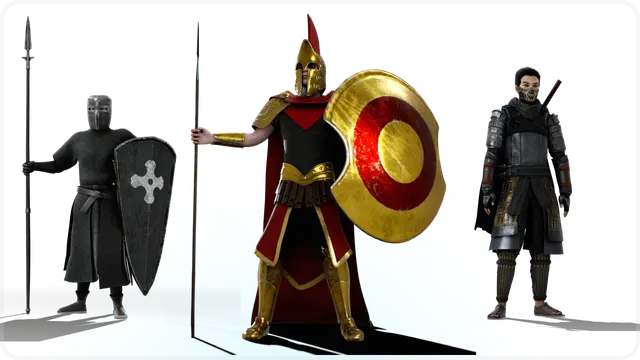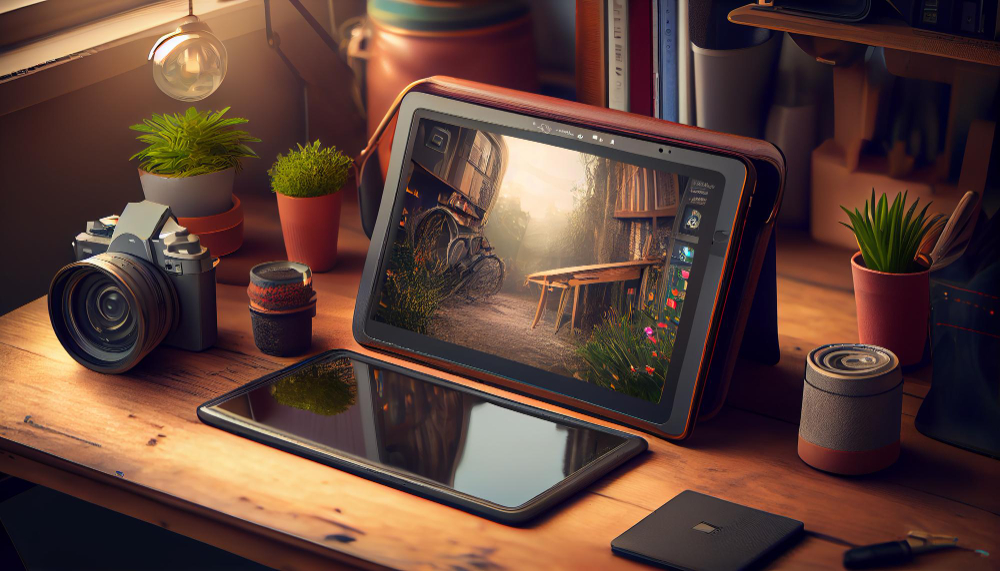Have you ever wondered how game developers bring your favorite online games to life? The answer lies in the intricate world of 3D models. Moreover, these 3D assets not only shape the visual appeal of games but also play a crucial role in immersing players in captivating experiences. However, as technology surges forward, creating 3D models from photos is in the spotlight, in addition this innovation is the game-changing force of artificial intelligence (AI).
In this comprehensive guide, we’ll explore the intricacies of creating 3D models from photos. Moreover, this will shed light on the step-by-step process, the tools and technologies involved, and the transformative impact of AI on game development.
1. Create 3D Model from Photos
So, the question is; is it possible to create 3D models from photos? The answer lies in photogrammetry, a transformative technique reshaping digital design by crafting 3D models from photographs. Then through capturing multiple images of an object from different perspectives, dedicated software reconstructs these visuals into detailed and precise 3D models. This method empowers artists, designers, and industries to seamlessly translate real-world subjects into elaborate digital representations, nurturing innovation and creativity across a spectrum of fields.
This innovative technique to create 3d models from photos bridges the gap between the real world and the digital realm, allowing developers to breathe life into their games by translating real-world images into intricate 3D models. This approach not only accelerates the modelling process but also introduces a layer of authenticity, capturing the essence of the physical world in virtual creations.
Role of 3d models in Game Development
Game developers rely on 3D models to shape characters, environments, and objects, crafting visually stunning landscapes that enhance the overall gaming narrative. However, the role of 3D models in game development is not merely aesthetic; it is the foundation upon which the entire interactive and visually compelling gaming experience is built.
Moreover, 3D models empower game developers to convey narrative depth and emotional resonance through lifelike characters and dynamic environments. The precision and creativity embedded in these models elevate gameplay, making them indispensable tools for developers in crafting engaging and unforgettable gaming adventures.
Importance of AI 3D Modeling for Game Development
This is the era of Artificial Intelligence, a game-changer in the landscape of 3D modeling for game development. AI has seamlessly woven itself into the fabric of this creative process, elevating it to new heights. The ability of AI to analyse, learn and adapt has streamlined and enhanced 3D modeling workflows. From generating intricate details to automating repetitive tasks, AI has become an indispensable tool in the hands of game developers, significantly influencing the efficiency and quality of the final output.
2. The Transition from 2D to 3D
The transformative prowess of AI, converting 2D assets into immersive 3D models, is revolutionising game design. AI algorithms adeptly craft 3D models from photos, infusing vitality into static elements and enriching the realism of virtual realms. This transition marks a paradigm shift for game developers, offering a canvas for inventive storytelling and innovative gameplay mechanics.
The impact of this shift on game developers is profound, akin to unlocking a treasure trove of creative possibilities. Beyond the visual transformation, the move from 2D to 3D AI introduces novel dimensions to gameplay, providing developers with newfound freedom. This liberation encourages experimentation with innovative concepts, ultimately enhancing the gaming experience for players. The amalgamation of AI’s transformative capabilities and game developers’ creativity ushers in an era where virtual worlds become more dynamic, engaging, and immersive than ever before.
The Evolution of 2D to 3D AI Technologies
The evolution from 2D to 3D AI technologies marks a pivotal moment in gaming history. AI’s ability to create 3D models from photos and seamlessly transition between dimensions has revolutionized the industry. This transition is not merely a technical advancement but a paradigm shift that empowers game developers to craft more immersive and visually compelling gaming environments.
3. Basics of 3D Models from Photos: Converting 2D Images to 3D Models
The journey from a 2D image to a dynamic 3D model is a fascinating transformation. Moreover, this process involves a series of intricate steps, where algorithms analyse the spatial information within the 2D image and extrapolate it into the third dimension. Through a combination of shape recognition, depth perception, and texture mapping, a once static image is transmuted into a dynamic and interactive 3D model, ready to inhabit the virtual landscapes of gaming environments.
Traditionally, the creation of 3D models relied heavily on manual labour, involving painstakingly detailed design work. However, the emergence of AI-driven approaches has revolutionised this landscape. AI algorithms, powered by machine learning, can now autonomously generate complex 3D models from photos, reducing the time and effort required.
Benefits of Harnessing AI for 3D Asset Creation
Swift Model Development: Embracing AI in 3D modelling expedites the entire process, liberating developers from laborious manual tasks. This accelerated workflow means more time can be dedicated to fostering creativity and refining design elements.
Precision Redefined: The adaptability of AI ensures a precision in 3D asset generation that surpasses traditional methods. With algorithms fine-tuned for accuracy, developers can count on detailed and realistic models, contributing to an enhanced visual experience.
Productivity Amplification: AI’s efficiency not only speeds up the modelling phase but also amplifies overall productivity. Developers can navigate projects with increased agility, meeting deadlines more effectively and delivering higher-quality outputs.
Innovation Unleashed: By streamlining manual tasks, AI liberates developers to explore new horizons of experimentation and innovation. The newfound efficiency encourages creative exploration, pushing the boundaries of what’s possible in the dynamic realm of game development.

4. Step-by-Step Guide: Creating 3D Models from Photos using AI
Image Selection: Begin by choosing high-quality photos of the subject from various angles. Ensure clarity and detail to provide ample data for the AI to work with.
AI Tool Implementation: Utilize a specialised AI tool, such as 3daily, to initiate the 3D modelling process. Upload the selected images and let the AI algorithm decipher the spatial information.
Processing and Reconstruction: Allow the AI to process the images, employing complex algorithms to reconstruct a 3D model. This step involves depth perception, shape recognition, and texture mapping.
Refinement and Editing: Fine-tune the generated 3D model, addressing any imperfections or refining specific details. This step may involve manual intervention to ensure accuracy.
Exporting the Model: Once satisfied with the model, export it in a compatible file format for integration into game development platforms or further editing in specialised software.
Tips and Best Practices for Efficient and Effective Modeling
Capture Diverse Angles: Ensure a comprehensive set of photos by capturing the subject from various angles. Thereby, this diversity enhances the AI’s ability to construct an accurate 3D model.
Optimize Image Quality: High-resolution images with clear details are crucial for precise modelling. Opt for well-lit environments to capture the subject with minimal shadows.
Utilise AI Features: Familiarize yourself with the features of the chosen AI tool. In addition, some tools offer options for customising details, refining textures, or even automating certain editing tasks.
Regular Backups: Throughout the process, regularly save versions of your work. This precaution ensures that you can revert to previous stages if needed and helps in maintaining a smooth workflow.
Experiment and Iterate: Embrace a mindset of experimentation. Don’t hesitate to iterate on the model, adjusting parameters, and refining details to achieve the desired outcome.
5. AI-Generated 3D Models in Game Development
In the ever-evolving landscape of game development, the integration of AI-generated models has become a transformative game-changer. However, these models seamlessly weave into virtual environments, offering a dynamic and efficient way to populate game worlds with intricate and diverse assets. The flexibility of AI-generated models allows developers to easily adapt and modify their creations, ensuring a harmonious blend with the overall aesthetic and narrative of the game.
Moreover, the adaptability of AI-generated models extends beyond their initial creation. As game narratives evolve or developers seek to introduce fresh content, AI’s flexibility becomes a crucial asset. Modifications and updates to existing models can be seamlessly implemented, saving valuable time and resources. Thereby, this dynamic interaction between developers and AI-generated assets paves the way for a more responsive and creative game development process, where the virtual world can be shaped and reshaped with unprecedented ease. The integration of AI-generated 3D models not only enhances visual appeal but also establishes a new paradigm for efficiency and creativity in the ever-expanding realm of game development.
Performance Considerations and Optimization Tips
Strategic Reduction of Polygon Counts: To ensure optimal performance, developers should strategically reduce the polygon counts in AI-generated models. This involves simplifying the geometry while retaining essential details, striking a balance between visual richness and computational efficiency.
Texture Optimization: Texture optimization is a key aspect in enhancing performance. By employing compressed and appropriately sized textures, developers can maintain high-quality visuals without overburdening the system resources. This meticulous texture management contributes significantly to a smoother gaming experience.
Leveraging LOD (Level of Detail) Techniques: Implementing LOD techniques is a crucial strategy in managing performance. By adjusting the level of detail based on the viewer’s distance from the object, developers can optimise resources effectively. This ensures that distant or less visible AI-generated assets are rendered with lower detail, conserving computational power.
Streamlining Animation Complexities: For AI-generated models with animations, streamlining animation complexities is vital for optimal performance. Simplifying animations, minimizing unnecessary movements, and employing efficient skeletal structures contribute to a more responsive and resource-friendly gaming environment.
Dynamic Loading and Unloading Mechanisms: Introducing dynamic loading and unloading mechanisms is a smart approach to performance optimisation. Infact, this involves loading AI-generated assets dynamically based on the player’s proximity, ensuring that resources are allocated efficiently. In addition, unloading assets that are not immediately visible further contributes to a streamlined gaming experience.
6. Challenges and Solutions to create 3D Models from Photos
While the integration of AI in 3D modelling brings immense benefits, game developers encounter certain challenges. Moreover, tne common hurdle is the potential lack of control over the intricate details of AI-generated models. Developers may face issues with ensuring specific design elements align with the envisioned aesthetics. Additionally, achieving a consistent style across diverse assets poses another challenge, as AI may interpret styles differently.
However, to overcome these challenges, developers can implement a multi-step validation process, combining AI-generated models with manual fine-tuning. This ensures a meticulous review of details, allowing developers to maintain control over the final output. Furthermore, creating detailed design guidelines for the AI algorithms to follow helps in achieving a consistent and desired style. Balancing automation with manual oversight emerges as a powerful strategy, allowing developers to harness the efficiency of AI while preserving their creative vision.

7. Future Trends
Looking ahead, the future of AI-driven 3D modelling promises exciting advancements. Generative Adversarial Networks (GANs) are poised to play a pivotal role, offering more dynamic and responsive models. Furthermore, the integration of AI with Virtual Reality (VR) and Augmented Reality (AR) technologies is set to revolutionise immersive gaming experiences, blurring the lines between virtual and real. Additionally, AI-driven tools are likely to become more accessible and user-friendly, democratising their usage across a wider spectrum of developers, from seasoned professionals to indie studios.
8. Conclusion
To sum up, this guide on “3D Models from Photos: A Guide for Game Developers” illuminates the transformative synergy between AI, 3D modelling, and game development. Moreover, it underscores the importance of AI-driven 3D modelling tools for game developers, balancing efficiency and creativity. Moreover, this steps, coupled with tips and best practices, demystifies the process, offering insights into the dynamic landscape of game development. Furthermore, as the industry evolves, embracing AI-generated 3D models opens the door to unprecedented efficiency, flexibility, and creativity, laying the foundation for the future of immersive gaming experiences. Visit 3Daily today to learn about how to create 3d model from photos. Elevate your game development process, enhance efficiency, and unlock a new realm of possibilities.



